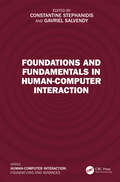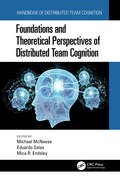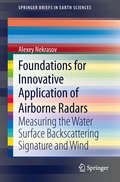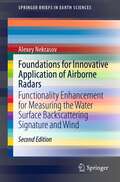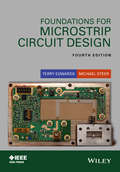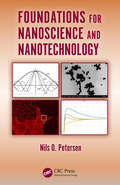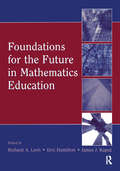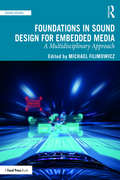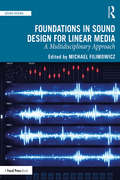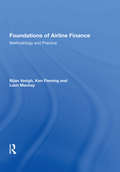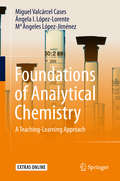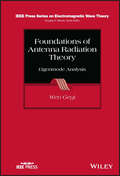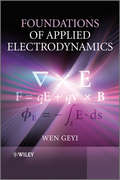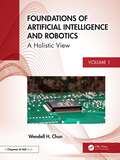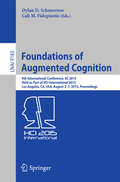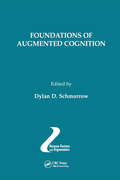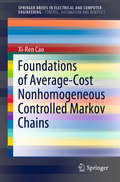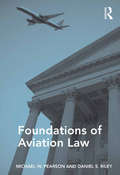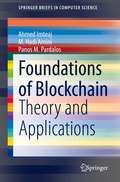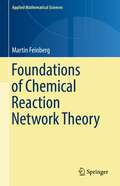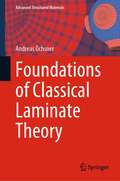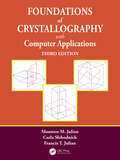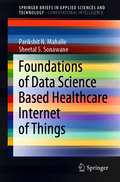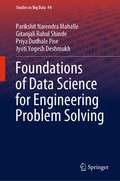- Table View
- List View
Foundations and Fundamentals in Human-Computer Interaction
by Gavriel Salvendy Constantine StephanidisThis book serves as a foundation to the field of HCI, equipping readers with the necessary knowledge and skills to engage in this field. This book Discusses human functionalities and characteristics relevant to interaction, including sensory perception, attention and memory, language and communication, emotions, decision-making, as well as mental models, human error, and human actions. Explores the evolution of HCI design approaches and the role of social and organizational psychology in HCI Discusses key concepts and societal aspects of interactive technologies, such as user acceptance, ethics, privacy, and trust. Covers the historical background, contributing disciplines, essential concepts, and theories within the domain. This book will appeal to individuals interested in Human–Computer Interaction research and applications.
Foundations and Theoretical Perspectives of Distributed Team Cognition
by Michael D. McNeese; Eduardo Salas; Mica R. EndsleyThe background and interwoven streams of team cognition and distributed cognition fermenting together has wielded new nuances of exploration, which continue to be relevant for a theoretical understanding of team phenomena. Foundations and Theoretical Perspectives of Distributed Teams Cognition looks at fundamentals, theoretical concepts, and how theory informs perspectives of thinking for distributed team cognition. The chapters yield a broad understanding of the nature of diverse thinking and insights into technologies, foundations, and theoretical perspectives of distributed team cognition. Features Generates historical patterns and significance that compose developmental trajectories Explains multiple perspectives that incorporate an interdisciplinary understanding that specifies diverse theories Identifies and develops particular challenges resident within team simulation studies and then illustrates research frameworks Highlights and reviews how team simulations are used to produce dynamic experimental results Investigates and studies research variables within distributed team cognition
Foundations for Innovative Application of Airborne Radars
by Alexey NekrasovThe 'wind vector' - wind speed and direction - is a main meteorological quantity and relevant for air-sea exchange processes. This book explores the use of several airborne microwave instruments, some of which are part of standard aircraft equipment, in determining the local wind vector over water. This is worthwhile as local wind information is usually only available at measurements sites like weather stations and airports, and global wind information from satellites has very coarse resolution and poor temporal coverage - at most a few times daily. In his book, Nekrasov uses known results in a novel way and gives explicit and application-oriented descriptions how to additionally retrieve local wind information from standard airborne microwave instruments. The results presented here are highly valuable for flight operation above the sea (e. g. , search-and-rescue) but also for complementing other measurements of atmospheric or oceanic parameters during research flights.
Foundations for Innovative Application of Airborne Radars: Functionality Enhancement for Measuring the Water Surface Backscattering Signature and Wind (SpringerBriefs in Earth Sciences)
by Alexey NekrasovThis book discusses methods for measuring the water surface backscattering signature and estimating the near-surface wind vector over water using airborne radars, in addition to their standard application. Airborne FMCW demonstrator system, Doppler navigation system, airborne weather radar, airborne radar altimeter, and airborne precipitation radar are analyzed in order to be used for that purpose. The radars functionality is enhanced for their operation in a scatterometer mode. A circle flight and/or a rectilinear flight of an aircraft over the water surface is considered depending on the radar design features to perform measurements of the azimuth normalized radar cross section curve of the water surface and/or the near-surface wind speed and direction. Flight recommendations to perform measurements along with algorithms for measuring the water surface backscattering signature and for retrieval of the wind speed and direction over water are presented.
Foundations for Microstrip Circuit Design
by Terry Edwards Michael SteerBuilding on the success of the previous three editions, Foundations for Microstrip Circuit Design offers extensive new, updated and revised material based upon the latest research. Strongly design-oriented, this fourth edition provides the reader with a fundamental understanding of this fast expanding field making it a definitive source for professional engineers and researchers and an indispensable reference for senior students in electronic engineering. Topics new to this edition: microwave substrates, multilayer transmission line structures, modern EM tools and techniques, microstrip and planar transmision line design, transmission line theory, substrates for planar transmission lines, Vias, wirebonds, 3D integrated interposer structures, computer-aided design, microstrip and power-dependent effects, circuit models, microwave network analysis, microstrip passive elements, and slotline design fundamentals.
Foundations for Nanoscience and Nanotechnology
by Nils O. PetersenDo you ever wonder why size is so important at the scale of nanosystems? Do you want to understand the fundamental principles that govern the properties of nanomaterials? Do you want to establish a foundation for working in the field of nanoscience and nanotechnology? Then this book is written with you in mind. Foundations for Nanoscience and Nanotechnology provides some of the physical chemistry needed to understand why properties of small systems differ both from their constituent molecular entities and from the corresponding bulk matter. This is not a book about nanoscience and nanotechnology, but rather an exposition of basic knowledge required to understand these fields. The collection of topics makes it unique, and these topics include: The concept of quantum confinement and its consequences for electronic behaviour (Part II) The importance of surface thermodynamics for activity and interactions of nanoscale systems (Part III) The need to consider fluctuations as well as mean properties in small systems (Part IV) The interaction of light with matter and specific applications of spectroscopy and microscopy (Part V) This book is written for senior undergraduates or junior graduate students in science or engineering disciplines who wish to learn about or work in the areas of nanoscience and nanotechnology, but who do not have the requisite background in chemistry or physics. It may also be useful as a refresher or summary text for chemistry and physics students since the material is focused on those aspects of quantum mechanics, thermodynamics, and statistical mechanics that specifically relate to the size of objects.
Foundations for the Future in Mathematics Education
by Richard A. Lesh; Eric Hamilton; James J. KaputThe central question addressed in Foundations for the Future in Mathematics Education is this: What kind of understandings and abilities should be emphasized to decrease mismatches between the narrow band of mathematical understandings and abilities that are emphasized in mathematics classrooms and tests, and those that are needed for success beyond school in the 21st century? This is an urgent question. In fields ranging from aeronautical engineering to agriculture, and from biotechnologies to business administration, outside advisors to future-oriented university programs increasingly emphasize the fact that, beyond school, the nature of problem-solving activities has changed dramatically during the past twenty years, as powerful tools for computation, conceptualization, and communication have led to fundamental changes in the levels and types of mathematical understandings and abilities that are needed for success in such fields. For K-12 students and teachers, questions about the changing nature of mathematics (and mathematical thinking beyond school) might be rephrased to ask: If the goal is to create a mathematics curriculum that will be adequate to prepare students for informed citizenship—as well as preparing them for career opportunities in learning organizations, in knowledge economies, in an age of increasing globalization—how should traditional conceptions of the 3Rs be extended or reconceived? Overall, this book suggests that it is not enough to simply make incremental changes in the existing curriculum whose traditions developed out of the needs of industrial societies. The authors, beyond simply stating conclusions from their research, use results from it to describe promising directions for a research agenda related to this question. The volume is organized in three sections: *Part I focuses on naturalistic observations aimed at clarifying what kind of “mathematical thinking” people really do when they are engaged in “real life” problem solving or decision making situations beyond school. *Part II shifts attention toward changes that have occurred in kinds of elementary-but-powerful mathematical concepts, topics, and tools that have evolved recently—and that could replace past notions of “basics” by providing new foundations for the future. This section also initiates discussions about what it means to “understand” the preceding ideas and abilities. *Part III extends these discussions about meaning and understanding—and emphasizes teaching experiments aimed at investigating how instructional activities can be designed to facilitate the development of the preceding ideas and abilities. Foundations for the Future in Mathematics Education is an essential reference for researchers, curriculum developers, assessment experts, and teacher educators across the fields of mathematics and science education.
Foundations in Sound Design for Embedded Media: A Multidisciplinary Approach (Sound Design)
by Michael FilimowiczThis volume provides a comprehensive introduction to foundational topics in sound design for embedded media, such as physical computing; interaction design; auditory displays and data sonification; speech synthesis; wearables; smart objects and instruments; user experience; toys and playful tangible objects; and the new sensibilities entailed in expanding the concept of sound design to encompass the totality of our surroundings. The reader will gain a broad understanding of the key concepts and practices that define sound design for its use in computational products and design. The chapters are written by international authors from diverse backgrounds who provide multidisciplinary perspectives on sound in its many embedded forms. The volume is designed as a textbook for students and teachers, as a handbook for researchers in sound, programming and design, and as a survey of key trends and ideas for practitioners interested in exploring the boundaries of their profession.
Foundations in Sound Design for Linear Media: A Multidisciplinary Approach (Sound Design)
by Michael FilimowiczThis volume provides a comprehensive introduction to foundational topics in sound design for linear media, such as listening and recording; audio postproduction; key musical concepts and forms such as harmony, conceptual sound design, electronica, soundscape, and electroacoustic composition; the audio commons; and sound’s ontology and phenomenology. The reader will gain a broad understanding of the key concepts and practices that define sound design for its use with moving images as well as important forms of composed sound. The chapters are written by international authors from diverse backgrounds who provide multidisciplinary perspectives on sound in its linear forms. The volume is designed as a textbook for students and teachers, as a handbook for researchers in sound, media and experience, and as a survey of key trends and ideas for practitioners interested in exploring the boundaries of their profession.
Foundations of Airline Finance: Methodology and Practice
by Bijan VasighFoundations of Airline Finance: Methodology and Practice is a textbook that comprehensively covers, at a basic level, all aspects of the subject, bringing together many of the numerous and informative articles and institutional developments that have characterized the field of airline finance in the previous two decades. In the early chapters, the reader is introduced to the elementary theoretical foundations that underpin the role of finance in the airline industry. Critical topics, such as the time value of money, the notion of risk and return, and the complex nature of costs (fixed, semi-fixed, variable, and marginal) are discussed and illustrated with concrete examples. This is followed by an in-depth presentation of the role of accounting in airlines. Ratio analysis is used to further analyze airline financial statements. Airline industry specific metrics, such as cost per available seat mile (CASM) and revenue per revenue passenger mile (RRPM), are covered. The role of capital and asset management is then explained in the following chapters. The final chapters of the text present some important practical applications of the theoretical ideas presented earlier; these applications include hedging, the buy versus lease decision for aircraft and the question of the valuation of assets (mainly aircraft). Moreover, specific methods for actually calculating internal valuation are presented and evaluated. Foundations of Airline Finance: Methodology and Practice will be of greatest value to students who are contemplating entering financial management in the air transportation industry; however, the text will also serve as an accessible and comprehensive reference for industry professionals.
Foundations of Analytical Chemistry
by Miguel Valcárcel Cases Ángela I. López-Lorente Ma Ángeles López-JiménezThis book offers a completely new approach to learning and teaching the fundamentals of analytical chemistry. It summarizes 250 basic concepts of the field on the basis of slides. Each of the nine chapters offers the following features:• Introduction: Summary. General scheme. Teaching objectives.• Text containing the explanation of each slide.• Recommended and commented bibliography.• Questions to be answered.• Slides. A distinct feature of this novel book is its focus on the fundamental concepts and essential principles of analytical chemistry, which sets it apart from other books presenting descriptive overviews of methods and techniques.
Foundations of Antenna Radiation Theory: Eigenmode Analysis (IEEE Press Series on Electromagnetic Wave Theory)
by Wen GeyiFoundations of Antenna Radiation Theory Understand the theory and function of wireless antennas with this comprehensive guide As wireless technology continues to develop, understanding of antenna properties and performance will only become more critical. Since antennas can be understood as junctions of waveguides, eigenmode analysis—the foundation of waveguide theory, concerned with the unexcited states of systems and their natural resonant characteristics—promises to be a crucial frontier in the study of antenna theory. Foundations of Antenna Radiation Theory incorporates the modal analysis, generic antenna properties and design methods discovered or developed in the last few decades, not being reflected in most antenna books, into a comprehensive introduction to the theory of antennas. This book puts readers into conversation with the latest research and situates students and researchers at the cutting edge of an important field of wireless technology. The book also includes: Detailed discussions of the solution methods for Maxwell equations and wave equations to provide a theoretical foundation for electromagnetic analysis of antennas Recent developments for antenna radiation in closed and open space, modal analysis and field expansions, dyadic Green’s functions, time-domain theory, state-of-the-art antenna array synthesis methods, wireless power transmission systems, and more Innovative material derived from the author’s own research Foundations of Antenna Radiation Theory is ideal for graduate or advanced undergraduate students studying antenna theory, as well as for reference by researchers, engineers, and industry professionals in the areas of wireless technology.
Foundations of Applied Electrodynamics
by Wen GeyiFoundations of Applied Electrodynamics takes a fresh look at the essential concepts and methods of electrodynamics as a whole, uniting the most relevant contemporary topics under a common mathematical framework. It contains clear explanations of high-level concepts as well as the mutual relationships between the essential ideas of electromagnetic theory. Starting with the fundamentals of electrodynamics, it methodically covers a wide spectrum of research and applications that stem from electromagnetic phenomena, before concluding with more advanced topics such as quantum mechanics.Includes new advances and methodologies in applied electrodynamics, and provides the whole picture of the theory of electrodynamics in most active areas of engineering applicationsSystematically deals with eigenvalue problems, integral equation formulations and transient phenomena in various areas of applied electrodynamicsIntroduces the complete theory of spherical vector wave functions, and presents the upper bounds of the product of gain and bandwidth for an arbitrary antennaPresents the field approach to multiple antenna system, which provides a theoretical tool for the prediction of channel models of MIMO, and is also the basis of wireless power transmission systemOne of the first books on electromagnetics that contains the general theory of relativity, which is needed in the design of mobile systems such as global positioning system (GPS)By summarising both engineering and theoretical electromagnetism in one volume, this book is an essential reference for practicing engineers, as well as a guide for those who wish to advance their analytical techniques for studying applied electrodynamics.
Foundations of Artificial Intelligence and Robotics: Volume 1 A Holistic View
by Wendell H. ChunArtificial intelligence (AI) is a complicated science that combines philosophy, cognitive psychology, neuroscience, mathematics and logic (logicism), economics, computer science, computability, and software. Meanwhile, robotics is an engineering field that compliments AI. There can be situations where AI can function without a robot (e.g., Turing Test) and robotics without AI (e.g., teleoperation), but in many cases, each technology requires each other to exhibit a complete system: having "smart" robots and AI being able to control its interactions (i.e., effectors) with its environment. This book provides a complete history of computing, AI, and robotics from its early development to state‑of‑the‑art technology, providing a roadmap of these complicated and constantly evolving subjects.Divided into two volumes covering the progress of symbolic logic and the explosion in learning/deep learning in natural language and perception, this first volume investigates the coming together of AI (the mind) and robotics (the body), and discusses the state of AI today.Key Features: Provides a complete overview of the topic of AI, starting with philosophy, psychology, neuroscience, and logicism, and extending to the action of the robots and AI needed for a futuristic society Provides a holistic view of AI, and touches on all the misconceptions and tangents to the technologies through taking a systematic approach Provides a glossary of terms, list of notable people, and extensive references Provides the interconnections and history of the progress of technology for over 100 years as both the hardware (Moore’s Law, GPUs) and software, i.e., generative AI, have advanced Intended as a complete reference, this book is useful to undergraduate and postgraduate students of computing, as well as the general reader. It can also be used as a textbook by course convenors. If you only had one book on AI and robotics, this set would be the first reference to acquire and learn about the theory and practice.
Foundations of Augmented Cognition
by Dylan D. Schmorrow Cali M. FidopiastisThis book constitutes the proceedings of the 9th International Conference on the Foundations of Augmented Cognition, AC 2015, held as part of the 17th International Conference on Human-Computer Interaction, HCII 2015, which took place in Los Angeles, CA, USA, in August 2015. HCII 2015 received a total of 4843 submissions, of which 1462 papers and 246 posters were accepted for publication after a careful reviewing process. These papers address the latest research and development efforts and highlight the human aspects of design and use of computing systems. The papers thoroughly cover the entire field of Human-Computer Interaction, addressing major advances in knowledge and effective use of computers in a variety of application areas. The 78 papers presented in the AC 2015 proceedings address the following major topics: cognitive performance and work load, BCI and operational neuroscience, cognition, perception and emotion measurement, adaptive and tutoring training, applications of augmented cognition.
Foundations of Augmented Cognition (Human Factors and Ergonomics)
by Dylan D. SchmorrowBringing together a comprehensive and diverse collection of research, theory, and thought, this volume builds a foundation for the new field of Augmented Cognition research and development. The first section introduces general Augmented Cognition methods and techniques, including physiological and neurophysiological measures such as EEG and fNIR; a
Foundations of Average-Cost Nonhomogeneous Controlled Markov Chains (SpringerBriefs in Electrical and Computer Engineering)
by Xi-Ren CaoThis Springer brief addresses the challenges encountered in the study of the optimization of time-nonhomogeneous Markov chains. It develops new insights and new methodologies for systems in which concepts such as stationarity, ergodicity, periodicity and connectivity do not apply. This brief introduces the novel concept of confluencity and applies a relative optimization approach. It develops a comprehensive theory for optimization of the long-run average of time-nonhomogeneous Markov chains. The book shows that confluencity is the most fundamental concept in optimization, and that relative optimization is more suitable for treating the systems under consideration than standard ideas of dynamic programming. Using confluencity and relative optimization, the author classifies states as confluent or branching and shows how the under-selectivity issue of the long-run average can be easily addressed, multi-class optimization implemented, and Nth biases and Blackwell optimality conditions derived. These results are presented in a book for the first time and so may enhance the understanding of optimization and motivate new research ideas in the area.
Foundations of Aviation Law
by Michael W. Pearson Daniel S. RileyFoundations of Aviation Law is an easy-reading general primer into the often complex world of aviation law, written for aviation students as well as legal professionals who are looking for broad-based, introductory coverage of the subject. The text begins with basic legal concepts that build a foundation for in-depth exploration of aviation-specific subject matter. This allows the instructor to utilize one text in situations where a basic foundation in law is required before moving into aviation law specifics. It includes citations to relevant and key court decisions that provide a solid underpinning for the student of aviation law. The book is divided into six general categories, with fifteen relevant sub-chapters, allowing focused learning into particular areas of law. Throughout it features chapter summaries, key word indices and review questions. The design easily allows instructors to develop syllabi that spotlight the specific area of law that they are interested in exploring, providing comprehensive coverage of both traditional introductory legal concepts and topical aviation subject matter.
Foundations of Blockchain: Theory and Applications (SpringerBriefs in Computer Science)
by Panos M. Pardalos M. Hadi Amini Ahmed ImteajThis book provides a comprehensive analysis of fundamental topics related to blockchain. Throughout, the authors explore different vital issues and specific areas of blockchain. For convenience, the authors present the elementary description, visualize the working procedure of blockchain paradigm, and highlight the areas it can be applied in real life. They explain the blockchain process from a diverse perspective i.e. distributed Internet of Things (IoT), interdependent networks, intelligent mining, etc. They also analyze the interconnection of a blockchain network and such novel research areas to show a pathway towards a new research direction. This book also holds the core challenges and open research issues of blockchain technology, considering existing applications. Chapters include consensus mechanisms of blockchain, blockchain applicability in centralized and decentralized internet of things, blockchain interoperability from the perspective of interdependent networks, and blockchain for resource-constrained devices.Specifies the importance of theoretical methods in dealing with problems in the context of blockchain for interdependent decision making;Provides a comprehensive investigation of blockchain algorithms and the recently developed methods based on this algorithm;Provides basics and mathematical foundations needed to learn and deploy blockchain.
Foundations of Chemical Reaction Network Theory (Applied Mathematical Sciences #202)
by Martin FeinbergThis book provides an authoritative introduction to the rapidly growing field of chemical reaction network theory. In particular, the book presents deep and surprising theorems that relate the graphical and algebraic structure of a reaction network to qualitative properties of the intricate system of nonlinear differential equations that the network induces. Over the course of three main parts, Feinberg provides a gradual transition from a tutorial on the basics of reaction network theory, to a survey of some of its principal theorems, and, finally, to a discussion of the theory’s more technical aspects. Written with great clarity, this book will be of value to mathematicians and to mathematically-inclined biologists, chemists, physicists, and engineers who want to contribute to chemical reaction network theory or make use of its powerful results.
Foundations of Classical Laminate Theory (Advanced Structured Materials #163)
by Andreas ÖchsnerThis book provides a systematic and thorough introduction to the classical laminate theory based on the theory for plane elasticity elements and classical (shear–rigid) plate elements. It focus on unidirectional lamina which can be described based on orthotropic constitutive equations and their composition to layered laminates. In addition to the elastic behavior, failure is investigated based on the maximum stress, maximum strain, Tsai–Hill and the Tsai–Wu criteria.
Foundations of Computer Technology
by Alexander John AndersonFoundations of Computer Technology is an easily accessible introduction to the architecture of computers and peripherals. This textbook clearly and completely explains modern computer systems through an approach that integrates components, systems, software, and design. It provides a succinct, systematic, and readable guide to computers, providing a springboard for students to pursue more detailed technology subjects.This volume focuses on hardware elements within a computer system and the impact of software on its architecture. It discusses practical aspects of computer organization (structure, behavior, and design) delivering the necessary fundamentals for electrical engineering and computer science students. The book not only lists a wide range of terms, but also explains the basic operations of components within a system, aided by many detailed illustrations. Material on modern technologies is combined with a historical perspective, delivering a range of articles on hardware, architecture and software, programming methodologies, and the nature of operating systems. It also includes a unified treatment on the entire computing spectrum, ranging from microcomputers to supercomputers.Each section features learning objectives and chapter outlines. Small glossary entries define technical terms and each chapter ends with an alphabetical list of key terms for reference and review. Review questions also appear at the end of each chapter and project questions inspire readers to research beyond the text. Short, annotated bibliographies direct students to additional useful reading.
Foundations of Crystallography with Computer Applications
by Maureen M. Julian Carla Slebodnick Francis T. JulianThe third edition of Foundations of Crystallography with Computer Applications is a textbook for undergraduate and graduate students studying the solid state in chemistry, physics, materials science, geological sciences, and engineering. It takes a straightforward, logical approach to explaining how atoms are arranged in crystals and how crystal systems are related to each other. New to this edition is the inclusion of interactive Starter Programs in Python, which allow the students to focus on concepts and not treat crystallographic programs as "black boxes." Since many students have trouble visualizing three dimensional constructions, this book begins with detailed discussions in two dimensions leading up to the three-dimensional understanding. The first seven chapters introduce the fundamental principles, Chapter 8 suggests student projects, and the final seven chapters give detailed examples of the seven crystal systems. Key features: Uses Python, the leading open-source scientific language, with libraries including NumPy for matrix manipulations, Matplotlib for graphics, and Mplot3d for interactive 3-D modeling. Provides a gentle introduction to Python with Jupyter Notebooks, which combine interactive code and formatted documentation. Color codes both point group and space group diagrams using a new scheme devised by the author to emphasize the change of handedness of the symmetry operations and their consequences. Suggests student projects with data that can be found in the free Teaching Subset of the Cambridge Structural Database, the American Mineralogist Crystal Structure Database, and others. This book’s thorough but accessible style gives students a strong foundation in the subject. Over one thousand students have successfully used this book at Virginia Tech, and many more will continue to benefit from this new edition.
Foundations of Data Science Based Healthcare Internet of Things (SpringerBriefs in Applied Sciences and Technology)
by Parikshit N. Mahalle Sheetal S. SonawaneThis book offers a basic understanding of the Internet of Things (IoT), its design issues and challenges for healthcare applications. It also provides details of the challenges of healthcare big data, role of big data in healthcare and techniques, and tools for IoT in healthcare. This book offers a strong foundation to a beginner. All technical details that include healthcare data collection unit, technologies and tools used for the big data analytics implementation are explained in a clear and organized format.
Foundations of Data Science for Engineering Problem Solving (Studies in Big Data #94)
by Gitanjali Rahul Shinde Parikshit Narendra Mahalle Priya Dudhale Pise Jyoti Yogesh DeshmukhThis book is one-stop shop which offers essential information one must know and can implement in real-time business expansions to solve engineering problems in various disciplines. It will also help us to make future predictions and decisions using AI algorithms for engineering problems. Machine learning and optimizing techniques provide strong insights into novice users. In the era of big data, there is a need to deal with data science problems in multidisciplinary perspective. In the real world, data comes from various use cases, and there is a need of source specific data science models. Information is drawn from various platforms, channels, and sectors including web-based media, online business locales, medical services studies, and Internet. To understand the trends in the market, data science can take us through various scenarios. It takes help of artificial intelligence and machine learning techniques to design and optimize the algorithms. Big data modelling and visualization techniques of collected data play a vital role in the field of data science. This book targets the researchers from areas of artificial intelligence, machine learning, data science and big data analytics to look for new techniques in business analytics and applications of artificial intelligence in recent businesses.
